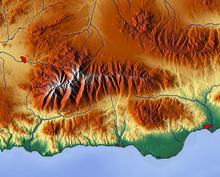Terrain
This article needs additional citations for verification. (July 2012) |


Terrain or relief (also
In physical geography, terrain is the lay of the land. This is usually expressed in terms of the elevation, slope, and orientation of terrain features. Terrain affects surface water flow and distribution. Over a large area, it can affect weather and climate patterns.
Importance
The understanding of terrain is critical for many reasons:
- The terrain of a region largely determines its suitability for human settlement: flatter alluvial plains tend to have better farming soils than steeper, rockier uplands.[1]
- In terms of Storm Water Management Model or DSSAM Models) to allow prediction of river water quality.
- Understanding terrain also supports Contour ploughing is an established practice enabling sustainable agricultureon sloping land; it is the practice of ploughing along lines of equal elevation instead of up and down a slope.
- Terrain is militarily critical because it determines the ability of armed forces to take and hold areas, and move troops and material into and through areas. An understanding of terrain is basic to both defensive and offensive strategy. The military usage of "terrain" is very broad, encompassing not only landform but land use and land cover, surface transport infrastructure, built structures and human geography, and, by extension under the term human terrain, even psychological, cultural, or economic factors.[4]
- Terrain is important in determining weather patterns. Two areas geographically close to each other may differ radically in precipitation levels or timing because of elevation differences or a rain shadow effect.
- Precise knowledge of terrain is vital in aviation, especially for low-flying routes and maneuvers (see terrain collision avoidance) and airport altitudes. Terrain will also affect range and performance of radars and terrestrial radio navigation systems. Furthermore, a hilly or mountainous terrain can strongly impact the implementation of a new aerodrome and the orientation of its runways.
Relief
Relief (or local relief) refers specifically to the quantitative measurement of vertical elevation change in a
Geomorphology
Geomorphology is in large part the study of the formation of terrain or topography. Terrain is formed by concurrent processes operating on the underlying geological structures over geological time:
- volcanic eruptions, etc.
- Erosional water, wind, chemical and gravitational (mass movement); such as landslides, downhill creep, flows, slumps, and rock falls.
- Extraterrestrial: meteorite impacts.
Land surface parameters are quantitative measures of various
Land surface objects, or
or borders of specific landforms.Digital terrain model

A digital elevation model (DEM) or digital surface model (DSM) is a 3D computer graphics representation of elevation data to represent terrain or overlaying objects, commonly of a planet, moon, or asteroid. A "global DEM" refers to a discrete global grid. DEMs are used often in geographic information systems (GIS), and are the most common basis for digitally produced relief maps. A digital terrain model (DTM) represents specifically the ground surface while DEM and DSM may represent tree top canopy or building roofs.
While a DSM may be useful for landscape modeling, city modeling and visualization applications, a DTM is often required for flood or drainage modeling, land-use studies,[14] geological applications, and other applications,[15] and in planetary science.See also
- Applications of global navigation satellite systems (GNSS)
- Cartographic relief depiction(2D relief map)
- Geographic information system (GIS)
- Geomorphometry
- Hypsometry
- Isostasy
- Physical terrain model
- Relief ratio
- Subterranea
- Terrain awareness and warning system
- Terrane
- Topography
References
- ISBN 978-0-12-804299-1. Retrieved October 11, 2022.
- U.S. Geological Survey. p. 72.
- )
- ^ "Joint Publication 1-02" (PDF). Department of Defense Dictionary of Military and Associated Terms.
* "compartmentation ... [involves] areas bounded on at least two sides by terrain features such as woods..."
* "culture — A feature of the terrain that has been constructed by man. Included are such items as roads, buildings, and canals; boundary lines; and, in a broad sense, all names and legends on a map."
* "key terrain — Any locality, or area, the seizure or retention of which affords a marked advantage to either combatant."
* "terrain intelligence — Intelligence on the military significance of natural and manmade characteristics of an area." - ISBN 9780582301566.
- ISBN 9780387786827 – via Google Books.
- .
- .
- .
- .
- .
- ^ Hoth et al. (2006), pp. 201–225; Bonnet, Malavieille & Mosar (2007); King, Herman & Guralnik (2016), pp. 800–804
- ^ University of Cologne (23 August 2016). "New insights into the relationship between erosion and tectonics in the Himalayas". ScienceDaily.
- ^ I. Balenovic, H. Marjanovic, D. Vuletic, etc. Quality assessment of high density digital surface model over different land cover classes. PERIODICUM BIOLOGORUM. VOL. 117, No 4, 459–470, 2015.
- ^ "Appendix A – Glossary and Acronyms" (PDF). Severn Tidal Tributaries Catchment Flood Management Plan – Scoping Stage. UK: Environment Agency. Archived from the original (PDF) on 2007-07-10.
Bibliography
- Bonnet, C.; Malavieille, J.; Mosar, J. (2007). "Interactions between tectonics, erosion, and sedimentation during the recent evolution of the Alpine orogen: Analogue modeling insights" (PDF). S2CID 131347609.
- Hoth, S.; Adam, J.; Kukowski, N.; Oncken, O. (2006). "Influence of erosion on the kinematics of bivergent orogens: Results from scaled sandbox simulations. Special Paper". .
- King, G.; Herman, F.; Guralnik, B. (2016). "Northward migration of the eastern himalayan syntaxis revealed by OSL thermochronometry". S2CID 206647417.
Further reading
- Boots on the ground. On military terrain from the perspective of the combat soldier. By Derek Gregory
External links
![]() The dictionary definition of terrain at Wiktionary
The dictionary definition of terrain at Wiktionary
